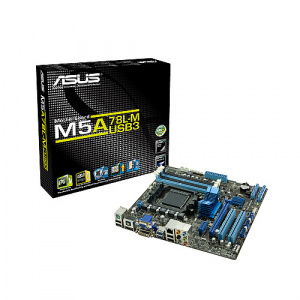Asus M5A78L-M/USB3

General Specs
- Socket
- AM3+
- Chipset
- AMD 760G (780L)/SB710
- Tested Processor
- AMD FX4350
- Graphic: Integrated ATI Radeon™ HD 3000 GPU
- LAN: Realtek®, 1 x Gigabit LAN Controller(s)
- Audio: VIA VT1708S 8-Channel High Definition Audio CODEC
- USB Ports:
- Built-in Controller : 10 x USB 2.0 port(s) (4 at back panel, black, 6 at mid-board)
- Built-in Controller : 2 x USB 3.1 Gen 1 port(s) (2 at back panel, blue)
- Release Date: 2017
Devices
| Component | Name | HardwareID | Status | Driver |
|---|---|---|---|---|
| Processor | AMD FX4350 | N/A | ACPI | |
| HDD - SATA | AMD/ATI SB7x0/SB8x0/SB9x0 SATA Controller [AHCI mode] | 1002:4391 | OS2AHCI, DANIS506 | |
| Audio | AMD/ATI SBx00 Azalia (Intel HDA) | 1002:4383 | UNIAUD | |
| Network | Intel Corporation 82545GM Gigabit Ethernet Controller | 8086:1026 | ||
| Video (AGP) | AMD/ATI RS780L [Radeon 3000] | 1002:9616 | SNAP Graphics, Panorama | |
| Audio (AGP) | AMD/ATI RS780 HDMI Audio [Radeon (HD) 3000 Series] | 1002:960F | ||
| USB (EHCI) | AMD/ATI SB7x0/SB8x0/SB9x0 USB EHCI Controller | 1002:4396 | ||
| USB (OHCI) | AMD/ATI SB7x0/SB8x0/SB9x0 USB OHCI0 Controller | 1002:4397 | ||
| USB (OHCI) | AMD/ATI SB7x0 USB OHCI1 Controller | 1002:4398 | ||
| USB (OHCI) | AMD/ATI SB7x0/SB8x0/SB9x0 USB OHCI2 Controller | 1002:4399 | ||
| USB (xHCI) | ASMedia ASM1042A USB 3.0 Host Controller | 1B21:1142 | Not supported |
General Comments
- Report by Doug Clark
- I have three machines. All three use the same motherboard (Asus M5A78L-M) and the same processor (AMD FX4350).
- One machine runs eComstation, WSeB, Panorama and is hooked to a Dell 27 inch monitor.
- The second machine runs Win7. The third runs AOS with SNAP and has an ATI X600 video card. The second and third machines are connected to two Samsung 27 inch monitors as dual head with two VGA KVM switches. The Win7 machine has a DVI to VGA adapter so that it can hook to the KVM. The ATI X600 has a y cable that converts the output socket on the video card into two VGA signals. (You can get Y cables for the x600 to convert to 2 DVI, 2 VGA, or 1 DVI and 1 VGA)
- When I got my first 27 inch monitor a few years ago (the Samsung) I tried it both as DVI and as VGA. The VGA actually looked clearer when running OS/2. Plus VGA KVMs are cheaper than DVI. Since VGA seemed to have a clearer picture (the lettering/fonts were clearer) and the KVMs are cheaper I have no really pressing desire to use DVI.
- I have not run benchmarks on Panorama verses SNAP. But I can't see any speed or performance difference in OS/2 between the SNAP machine and the Panorama machine. Both run videos (using VLC) just fine. Both scroll text in EPM or other editors as fast as I can drag the cursor, and drag windows across the desktop the same. I also cannot see any video performance differences between the Win7 machine and the AOS machine. The Win7 machine is using the video chipset on the motherboard; the AOS is using the ATI x600 card plugged into a slot.
- The big advantages of SNAP over Panorama are 1) dual head function, 2) SNAP blanks out the screen after a certain amount of time and Panorama does not, 3) SNAP runs Win-OS2 sessions better, or at all. However the Win-OS2 function of Panorama verses SNAP may be related to the machines (and their bios) that I happen to be running Panorama on verses the the machines I am running SNAP on.
- It used to be that Panorama was very slow compared to SNAP. My experience now is there is no noticeable difference performance wise. I am also running Panorama on an Lenovo i5 2013 vintage laptop and the performance is fine; but Win-OS2 doesn't work.
- I also noticed a few months ago that there are now "dual channel" KVMs that support two inputs for each machine and have two outputs, so you can use a dual monitor setup between multiple machines without having to use two KVMs, like I am using. I have seen them for both VGA and DVI.
- The motherboard has USB2 and USB3. The on-motherboard network chip works, as does the audio. However I have inserted an Intel Pro 1000 network adapter because I found, for some reason, that adapter and driver works better with Netbios and the WPS than the on-board network chip. The on-board network chip works fine for TCP/IP., and it works fine on the WSeB server in server function.
- I am using WSeB as a file server, and connecting to the WSeB via netbios. The Netbios performance issues showed up two ways: 1) copying a file from one machine to another from the command prompt took FOREVER, and 2) the first time I would open a WPS drive object for a drive on the server it took 20 to 30 seconds, or more, for the drive object to populate. This also, for some reason, affected the FOC, making it slow to display at times. But it did not affect Larsen Commander. Very strange. This was not an issue when connecting to the Samba server running on the WSeB machine. Installing the Intel network card and driver on the client machine fixed theses issues, regardless of whether the WSeB machine was running the network chipset on the motherboard or the Intel card. I have come to the conclusion the issue was between the chipset driver and the WPS.